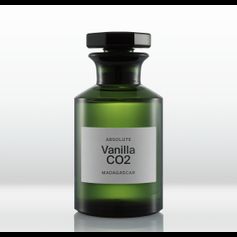Vanilla Madagascar CO2 Absolute
Origin: Madagascar
Product range : CO2
Process : Supercritical CO2 extraction process
Part used : Pods
Aspect : Crystallized
Color : Yellow Orange
Olfactive family : Gourmand
Application : Flavour EU, Flavour US, Fragrance, Flavour Japan China Korea
Geographical origin : Madagascar
Certifications : Kosher
- Details and product descriptionIntroduction:
Vanilla belongs to the Orchid family. It is a climbing herbaceous plant living in hot and humid regions of Central America where it originated. Cultivated throughout the tropics, it thrives in shade and volcanic soils. The vanilla plant has simple flat lanceolate leaves and irregular flowers that form spikes. The fruit is a pod or bean which is picked before it reaches maturity when it is green and odorless. A series of curing processes enables the aroma and flavor to develop.
History:Vanilla beans were first harvested from wild orchids in Mexico. Vanilla must have attracted attention in its natural habitat when the barely ripe long thin pods of these plants fell, fermenting under the cover of a layer of humus and emitting an exquisite aroma. The first mention of vanilla is found in the Chronicle of the Aztec ruler Itzcoalt (1427-1440). The Aztecs used a preparation method that enabled the spice to preserve its flavor and probably used it for centuries in the production of cocoa drinks, to soften the bitterness of chocolate. In the Aztec language, vanilla was called “tlixotchitl”, which means “black pod.” More than a century later, Europeans gave it a Latin-sounding name that was easier for Westerners to pronounce. Christopher Columbus first brought it to the European continent when he returned from his third trip to the new world in 1518. The Spanish conquistador Hernan Cortes brought the first Mexican vanilla plants to Europe. The drink was presented to the sovereigns of Spain, Isabella and Ferdinand of Aragon, and was adopted by the Court of Madrid. According to an officer’s account, when Hernan Cortes and his soldiers entered the city of Tenochtitlan (today’s Mexico City), the Aztec emperor Montezuma offered them a chocolate drink flavored with vanilla in golden cups. They also found vanilla pods among jewelry and feather ornaments. The Pre-Columbians used vanilla as a diuretic and a purgative. They attributed aphrodisiac and curative powers to it. For over 2 centuries, Mexico retained the monopoly of vanilla cultivation. All attempt to produce this orchid outside its natural habitat ended in failure. Finally, in the 19th century, it was discovered that a kind of bee specific to Mexico, the Melipona bee, was playing a crucial role in fertilization, which was indispensable for fruit formation. Botanists took several years to realize that the male and female organs of the flower were separated by an impervious membrane called the “rostellum.” In 1836 the Belgian botanist Charles Morren discovered a method to artificially pollinate the orchid. A few years later on Reunion Island, in 1841, a 12-year-old Bourbonnais slave, Edmond Albuis, figure out by himself how to replace the Melipona bee. His method is so simple that it is still used today. Each flower must be fertilized by hand, one by one! In this way, he managed to reproduce the plant. This plant was the parent of the entire vanilla crop in Madagascar and Reunion. Since then, the large island of Madagascar has become the world’s largest producer of vanilla. Madagascar’s vanilla is recognized as the best in the world thanks to the excellent composition of the soil in the northeastern part of the island, its ideal climate, and the traditional know-how of the farmers.
